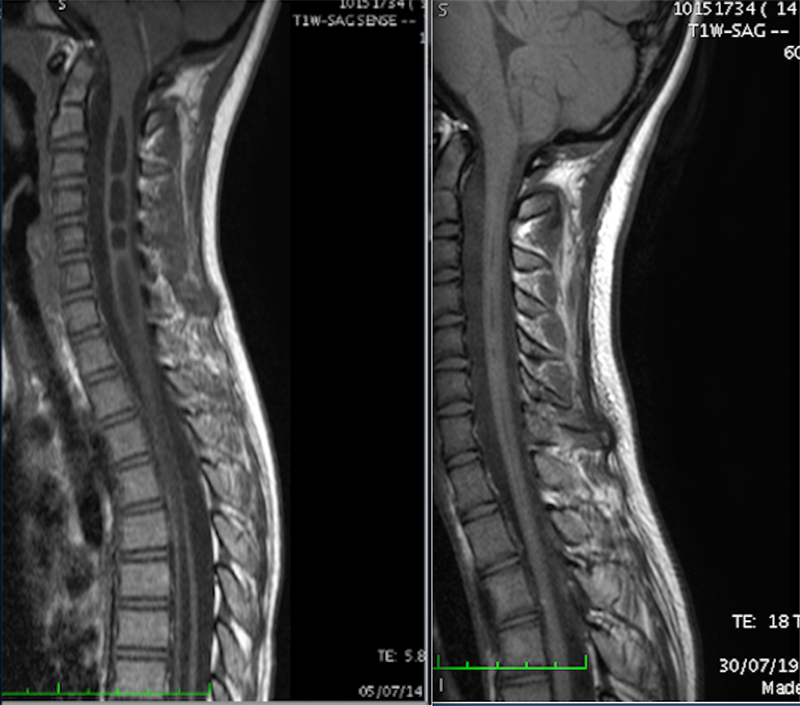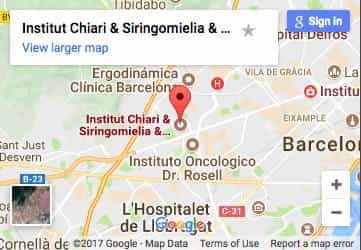Natsu Sato: Cord traction syndrome. Descent of the Cerebellar Tonsils (Arnold Chiari Syndrome Type I). Idiopathic Scoliosis and Idiopathic Syringomyelia.
Published by ICSEB at 29 September, 2020
Surgery date: 10/12/2013


Hello, I am the mother of a girl who underwent the Sectioning of the Filum Terminale aged 8 in December 2013. She was the fourth Japanese patient who underwent surgery at the Institut Chiari de Barcelona. It has been 6 years and half since the surgery was performed and everything has gone very well. Our daughter had a very severe Syringomyelic cavity, extended until the lumbar area, but 6 months after the surgery it decreased to a half, and after 18 months to a third. The cavity still persists, but it is decreasing little by little. After 2 years and a half, some changes were observed in the descent of the cerebellar tonsils, and after 4 years and a half there were even more improvements. Our daughter’s doctor in Japan was surprised by the result of the sectioning of the filum terminale and told us that, as the cavity has decreased that much so far, she should be fine if no symptoms appear. However, as the progression of scoliosis cannot be completely avoided, the Institut recommended us the Schroth method and, 4 months after surgery, our daughter began to practice it. For 4 years, we were able to slow down the progression of the scoliosis, but in December 2018 with the beginning of her development, our daughter’s curvature worsened up to 48 degrees. So, we decided to change rehabilitation centre, and after 1 month the curvature improved to 33 degrees and we followed the indications to keep improving the scoliosis.
Thanks to the Institut Chiari de Barcelona, our daughter has a normal life and goes to school like other children. I would like to explain how our daughter is doing 6 years and half after the surgery and the four obstacles we had to overcome in order for her to undergo surgery in Barcelona. I hope this testimonial will help those who suffer from the same diseases as hers.
How we got to the Institut Chiari de Barcelona
Our daughter was diagnosed with Scoliosis when she was 5 years old and she was monitored for 3 years. At the age of 7, she was recommended to have MRIs done, because her curvature worsened. It was then when we discovered that, apart from Scoliosis, she had Chiari I Malformation and Syringomyelia. They also told us that her Scoliosis was due to these two diseases, which had to be treated with neurosurgery before being able to start the Scoliosis treatment.
During the neurosurgical consultation, they told us that the treatment to be applied was the Craniectomy and, since the syringomyelic cavity extended until the lumbar region, it was severe and had to be operated immediately. “Why does our daughter have to go through all this? She is only 8!”, was what I was thinking in that moment. My husband and I, hesitant, started to search the internet for information on the diseases and the treatment. We discovered that Craniectomy is an invasive and high-risk intervention, which may require 2 or 3 further operations if the symptoms worsen, and yet with the possibility of no improvement. We found testimonials of Craniectomy patients with severe sequelae, so we started looking for alternatives to this surgery.
In the internet we found the sectioning of the filum terminale carried out according to the method that is applied at the Institut Chiari de Barcelona. We printed Dr. Royo’s publications and showed them to our daughter’s doctor. His reaction was like that of other doctors, who question the results of the method. However, once we decided that we were going to go to Barcelona for the intervention, he helped us prepare the images necessary to operate our daughter. We were lucky to find a doctor like him who respected our decision.
The first obstacle: establishing a good relationship with the Japanese doctor
Our daughter’s doctor waited until we decided which surgery our daughter would have, although she was meant to undergo a craniectomy, and he understood us when we told him that we were going to opt for the Institut Chiari’s method in Barcelona. We were not at all sure what to do, since our daughter had almost no symptoms of Syringomyelia and Chiari Malformation. We got in touch with Ms. Yuka Takahashi, responsible for Japanese patient care, with whom we established a relationship of trust, thanks to her attention and reliability. We also contacted Japanese patients who underwent surgery at the Institut to know their opinion. My husband and I opted for the sectioning of the filum Terminale, as it is a minimally invasive surgery, without sequelae and, if we had not obtained the desired result, we could then have considered the Craniectomy. At that time, we still had doubts about the effectiveness of the sectioning of the filum Terminale, although we would later change our mind as the syringomyelic cavity got incredibly reduced.
The second obstacle: the geographical distance
Unfortunately, there are no collaborating centres of the Institut Chiari de Barcelona in Japan. After the sectioning of the filum Terminale, I believe it is essential to be able to rely on a doctor in your area for check-ups. The team at the Institut was aware of the difficulties due to geographical distance and offered us orientation and collaboration, establishing a relationship of trust with our doctor in Japan in the post-operative period, which was of great help. If we have any questions about our daughter’s symptoms, we can consult the medical team through Ms. Yuka Takahashi and if we need to see a specialist, they recommend who to contact together with their opinion. Although we cannot consult the doctors in person, we are satisfied with the post-operative care of the Institut’s team.
The third obstacle: costs of intervention, travel and accommodation
Undoubtedly, the sectioning of the filum terminale surgery is more expensive than undergoing a Craniectomy in Japan, because in addition to the cost of the surgery, you must take into account the costs of traveling and accommodation in Barcelona.
The fourth obstacle: language issues and hotel and flight reservations
For those who are not used to travel to foreign countries, going to Barcelona for the intervention would be a challenge. We had no problems when booking a hotel, flight, nor did we have any difficulty communicating, since I have been abroad and I speak English. We didn’t have any concerns about the medical issue, as Ms. Takahashi always translated for us. For us, the 7-10 days of stay in Barcelona after surgery were probably more problematic, as we were alone and without a translator. We stayed in an apart-hotel with a kitchen and the day after discharge we went out for a walk, while they were cleaning the room. Every day we visited a tourist site, so we can say that the sectioning of the filum terminal is a minimally invasive intervention that allowed us to visit Barcelona.
To conclude: what we think about the Institut Chiari de Barcelona
At the Institut Chiari in Barcelona there are neurosurgeons and neurologists who are specialized in the treatment of conditions like Arnold-Chiari Syndrome type I, Scoliosis, Syringomyelia and Disc disease, and were able to visit our daughter following different perspectives. The preoperative consultation lasted more than an hour, during which they performed the neurological examination and thermography. In Japan we have never had such a detailed visit and, although we are not medical experts, we have been able to observe the changes in our daughter’s condition in the pre- and post-operative phase.
Every time our daughter gets MRIs or X-rays done, we send them to the Institut. The relationship with the doctors does not end with the surgery, but it is maintained over time with any consultation. Although our daughter has to go to rehabilitation every month, she has a normal life and the Institut Chiari in Barcelona taught us how to live with her condition. I hope that the sectioning of the filum Terminale will become an alternative – besides Craniectomy – for patients with the same conditions as our daughter’s, because this way their physical and psychological suffering could be reduced.


















